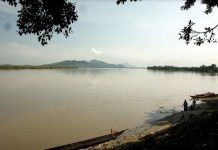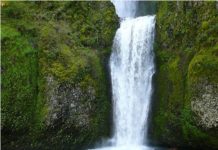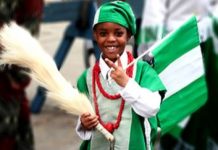I had a hard time sleeping, tossing and turning but soon after 5 am my digital alarm clock goes off. Laying there in my warm sleeping bag, I listen to the sounds of Kathmandu: the honk of horns, the jingle of bells. Instead of a real breakfast I quickly eat a few doughnuts that I bought the night before, and finish with a small thermos of coffee. And last thing before leaving the hotel room–something I always do when traveling–I make a quick search under the bed to make sure I haven’t forgotten anything.
Hoisting my heavy pack on my back, I head out the door of the hotel. In the darkness I clomp along in my heavy leather hiking boots, out the gate, and into the Kathmandu night. No cloud cover this morning, and a few stars twinkle through the moist, smoggy air. I signal a cruising taxi, bargain the price, and throw my pack in the back seat.
Driving through the damp streets toward the airport, pairs of glowing eyes bob in the inky black, the eyes of the skinny dogs that stalk the night. The street sweepers are up early brushing the pavement with brooms.
Outside the airport terminal there is a tea stall, and on a blackened kerosene stove sits a steaming pot. I buy a cup of tea and sit down to idle some time away watching the planes take off. A dog walks down the runway with an indifferent air.
I am flying into the Khumbu Valley, near the base of Mount Everest, to trek among the Sherpa people of Nepal. My small plane will land in Lukla (Elevation 8500 feet), a small airport in the Khumbu valley.
I ask a flight attendant when my plane will take off.
“Oh, eight or eight thirty” she says. I wait patiently until eleven o’clock when some buses show up to take passengers to the airplanes. I show my ticket to an official, and point to a Royal Nepal Airlines bus.
“Is that my bus?” I ask.
“Maybe”, she smiles.
I smile back, and continue waiting patiently. Its best to not get flustered when there are problems with schedules. I usually get where I am going. But I have been stranded a few times, and I’ve tried to develop the attitude that it is all part of the game.
As the sun rises, the day begins to warm, burning the last of the morning fog away.
At a little after 12:00, we finally get off the ground. I was told to be at the airport three hours early, at 7 am in the morning. The plane is finally leaving at twelve o’clock. I have been in the airport five hours. This is not an unusual event in Nepal.
Looking over my fellow passengers, I see there are four middle aged Japanese women, traveling with their Nepalese trekking guide. They are going on a three day hiking trip from the airstrip at Lukla to Namche. The other three or four passengers are local Sherpa people from the Solu Khumbu Valley, freighting supplies in for the upcoming trekking season. All the extra space has been packed with goods needed in a trekking lodge: kerosene pressure lamps, foam sleeping mats, and 100 pound sacks of rice.
Across the isle from me is a Sherpa man in his early 50’s. He is wearing a fur hat made from red fox fur. He has crinkles around the corners of his eyes, and distinguished looking grey at his temples.
“Nameste!’ I say. He returns the greeting, flashing me a grin that shows his gold tooth.
After take off the plane climbs out of the hazy blanket of air over Kathmandu and I can see the patchwork of fields, and the farms on the surrounding hillsides. Kathmandu is a city in a valley, but it is flat and surrounded by low hills.
Our prop plane drones up the Solu Khumbu valley, gateway to Mount Everest. From my birds eye view in the airplane, I can see in a single glance the entire geographic range from the tropical jungles to the arctic-like environment of the Himalayas.
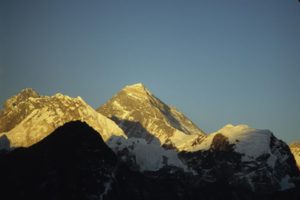 Approaching the high country, the plane banks around in the narrow valley and all of a sudden Mount Everest–the highest mountain in the world– looms into view.
Approaching the high country, the plane banks around in the narrow valley and all of a sudden Mount Everest–the highest mountain in the world– looms into view.
The flight goes smoothly, and I am happy to see the runway at Lukla. The runway is built at a slight uphill grade, and the tires of the plane gently touch down. After the smooth landing, the passengers respond with a clapping of hands once we are on solid ground. It is low tourist season—January–and I don’t see another trekker as I walk between the hotels that line the footpath through Lukla.
Many Sherpa men approach me who are out of work and want to guide me or act as a porter carrying my pack for a wage. But I do not like traveling with a guide or porter. I would much rather travel alone
Hiking through the mountains with a pack on my back, relying on no one but myself is a joy. With my simple needs in my backpack, I am dependent on no one, free to travel at any pace I like.
Standing on the outskirts of Lukla, I turn slowly, look at the mountains around me, and try to take it all in at once.
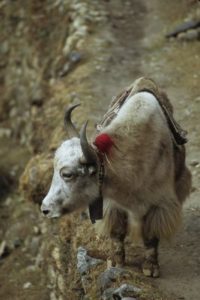 I take my first steps down the trail. My journey begins at the edge of Lukla, in wind and dust and silence. All around me are earthy scents: the warm smell of dark earth, manure of the livestock, and the clean smell of the mountain snows. The trail descends downhill at a steep slant, my pack is heavy and I can feel the shock of its weight in my knees. Donkey teams pass me, accompanied by the shrill whistles of the drivers.
I take my first steps down the trail. My journey begins at the edge of Lukla, in wind and dust and silence. All around me are earthy scents: the warm smell of dark earth, manure of the livestock, and the clean smell of the mountain snows. The trail descends downhill at a steep slant, my pack is heavy and I can feel the shock of its weight in my knees. Donkey teams pass me, accompanied by the shrill whistles of the drivers.
In the blazing sun I sit down on a stone bench. My head starts to throb. I begin developing a serious headache. It turns into the worst headache I have had in years. I feel as though my brains are bursting through my skull.
The reason is I have traveled almost instantly from Kathmandu down in the lowlands to 9,500 feet in the Himalayas. This is an elevation where many people are affected by altitude sickness. It will take a month for my body to fully adjust: my red blood cells will increase and grow larger, able to absorb more oxygen, and more of this oxygen will reach my tissues.
In any case, my head feels like there is liquid inside, sloshing around uncontrollably. I only walk a short distance and then come to an inn at a trail junction in the village of Chaplung (8700 feet) where I take a room and lay down for a couple hours staring at the ceiling, hoping my headache will go away, and eventually I fall asleep.
I fell asleep in mid-afternoon, and I wake up just as it is just getting dark. I still feel a little woozy. Stepping out on the porch, I can see there are many porters carrying heavy loads, walking up the trail in the fading light. They are walking up the hill to sell their wares at the Saturday market in Namche , which will happen tomorrow morning. They still have a long, long way to go, and they will be walking in the dark when they arrive.
The next morning, my headache gone, I am anxious to get out on the trail. A little stiff from yesterdays walking, I get a late start. The sun is already high in the blue sky when I finally get my sleeping bag stuffed into my pack and headed out the door, and on to the dusty trail. I hike through the day, through high farmland and small villages, and as civilization turns into forest the trail climbs through lush blue pine and rhododendron.
I am still a little lightheaded and decide to only hike the short distance to Ghat (7500 feet) at the confluence of the Kusum Khola and the Dudh Kosi. I arrive just at evening, the day almost ending, and find a lodge in a small settlement not far from the village. The lodge is so beautiful, I feel like I will stay awhile. In these populated parts of the mountains, the mountain huts and villages and flocks of livestock do not spoil the beauty of the countryside. In fact they rather add to the experience. Nepal is not a wilderness experience. All throughout the remotest parts of the mountains there are people living off the land.
After I take off my heavy pack and dump it on the ground, I just stand there, looking around. It is a beautiful evening, and I am glad to be here.
The innkeeper has a gaunt, lean face. Before I arrived he had cooked a plate of samosas and displayed them in the window to tempt passing trekkers. Samosas are potatoes rolled up in ground-flour and then deep fried. He put them on the wooden table in front of me with a small bowl of red chili to dip them in. He watches in amusement, a slight grin on his face, as I eat almost the whole plate of them– perhaps a dozen—which adds many rupees to my bill.
With the plate of good samosas in front of me on the rough table, I look around my surroundings. On the floor near the open hearth are some wicker baskets he has been working on, weaving them from strips of green bamboo.
While I dip the samosas in the bowl of chili, he explains ”Men in the Everest region usually work as climbing guides, whereas the people in the Annapurna region tend to join the Ghruka regiments.”
”I would like to have a job of some sort, but there is no work here except guiding trekkers and climbers.” he adds. Working as a guide for tourists, he has climbed Island Peak, a ‘trekking peak’, 20 times. He looks out the window with his moody brown eyes, lost in reflection. I can see a little concern in his face because of his unemployment predicament.
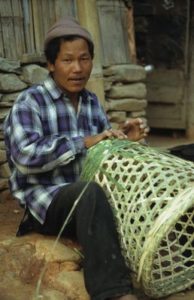 As darkness settles in and Pemba lights a gasoline pressure lamp, and starts cooking the evening’s dhal bhat over an open fire. The fireplace is in the middle of the kitchen, and has a large square vent built from hand-hewn boards. This vent lets the smoke go outside. While the rice cooks, Pemba sits cross-legged on the rough wooden floor and works on the bamboo that litters the room about us. As a sideline to his guiding and Trekker hostel, he makes ‘dokos’, a cone shaped pack used by porters. He weaves them from the bamboo that grows on the hillside nearby.
As darkness settles in and Pemba lights a gasoline pressure lamp, and starts cooking the evening’s dhal bhat over an open fire. The fireplace is in the middle of the kitchen, and has a large square vent built from hand-hewn boards. This vent lets the smoke go outside. While the rice cooks, Pemba sits cross-legged on the rough wooden floor and works on the bamboo that litters the room about us. As a sideline to his guiding and Trekker hostel, he makes ‘dokos’, a cone shaped pack used by porters. He weaves them from the bamboo that grows on the hillside nearby.
When the rice is done, Pemba dishes out the meal on large copper plates. We sit down at the small table, facing each other, and have a plate of Dhal Bhat.
I feel well satisfied. Much of the pleasure of trekking are these everyday experiences: the coarse food here in the hills, the simple pleasures of the mountain lodges, and carrying my pack through this rugged terrain all day.
The next morning, lying in my sleeping bag, I look out the window. The sun has not yet risen, and one faint star still lingers in the sky. My pack was loaded the night before, and so I have a hasty breakfast of muesli and say goodbye to Pemba.
Not so far out of Ghat, I enter the Everest region. Large boulders, fourty feet tall, guard the entrance of Sagarmata National Park. The harness of my pack is beginning to tire my shoulders. I am not yet used to its weight. Near the Park Headquarters is a pole bench where I place my heavy load. I pay the Park entrance fee, and they issue my trekking permit.
Ever since leaving Ghat I have walked above the gray rushing river, the Dudh Kosi, and I am tired when I reach Jorsale. Jorsale is the last village where there are lodges before Namche. In this section of the trail, from Lukla to Namche , some of the guest houses in the region have become very elaborate, catering to rich tourists and climbers. I try to find a simple lodge.
A low slung, wooden building looks good, so I knock on the heavy door. The door slowly opened, pushed wide, and the young woman running the lodge stood silently in the doorway. She is a girl of astonishing beauty, with high cheekbones and a lovely face. She is wearing the long grey woolen dress of the Sherpa women, and a string of red fossilized coral beads around her neck. After I ask the price of a room and drop off my pack, I sit down near the fire to warm up. I have a hot cup of tea, and I ask her what she is cooking.
“Vegatable fried rice with chapatis”, the girl answers in a soft voice. She sings while she cooks. The vegatables are being cooked in ghee, And the Chapattis are also cooked in ghee.
Ravenous as a wolf after my long walk, I tell her I would like some of the rice as well. I almost always eat the same food as the hotel owner rather than order something different. When the cook is working over an open fire it is easier to make only one type of food. After I have eaten, she comes outside and hands me a cup of Yak butter tea. Yak butter tea is a greasy yellow concoction, neither sweet nor clear, and it looks like soup rather than tea. The tea is made in the Tibetan style: Yak butter, tea leaves, and salt are placed in a churn, and mixed energetically with a plunger.
The next morning, after a hearty breakfast, I climb the west slope trail, out of the night canyon, into the sun. Before the hill up to Namche, the Dudh Kosi (milk river) heads up toward the East, and the Bhote Kosi goes to the West.
It is a long hard walk–three hours of brute labor in a blaze of sun unfiltered by the clouds –up the hill to Namche. There is no shelter along the way: there are no lodges, there are no tea houses. The trail is filled with heavily laden porters hiking toward the market. Yak teams are loaded with panniers containing sacks of rice. Three yaks, moving quickly, pass me on the trail. Their black tongues hang out and they are breathing hard with the physical exertion of carrying their load in the heat.
Finally Namche Bazarre appears at the crest of the hill. I quickly put my pack away in the Thamserku lodge, and I am eager to get to the open air market.
Shrill bargaining and the clanging of yak-bells. After walking for days in open countryside I am overwhelmed by the mass of people.
I Zig-zag my way through the crowd of coarse faced men. On their heads the men wear ‘topis’ (snug fitting caps) and at their waist the wicked looking curved dagger like knife—the kukri–sheathed in a wooden scabbard. There are also beautiful black haired women, young and lively. The Sherpa men idle about, their faces as calm as Bhuddha. There are also wrinkled Rai men from the lower country, wearing their topi, and many trekkers. There are Tibetan herdsmen with Mongolian features, and their long pony-tail hanging down their back.
Most of the trade goods have been carried in from Kathmandu: grains, transistor radios, and clothes, cooking pots. Other as far as the Terai offer vegetables and fruits that cannot be grown at these elevations. I buy a handful of raw garlic. I use it as a cure for colds or a sore throat I may get in the high country.
Despite its remote location, there is a bank, a post office, hotels and shops where one can buy second hand trekking gear and tinned food left over from expeditions and trekking groups. There is a clear running stream through the center of town, where people wash clothes and women sit and gossip. The air is thin here and intense cold by night. I spend some days to get used to the altitude.
It is essential to stay in Namche for at least two days to acclimatize to the altitude. After my rest days, I finally head up the valley and it is late in the evening when I arrive in the small settlement of Portse Tenga. I’ve stayed in this same lodge every time I came to Khumbu, and I am welcomed with gold toothed laughter from the woman running the place. There is a little party going on. Four Nepalese are celebrating some small event in their lives with mugs of chang, a mild home brewed beer, as well as swigging from a bottle of kukri rum.
All of us are sitting in a circle around the open hearth. The porters slurped tea, then loudly belched. In the smokey air, mingled with the odors of tobacco, the men somehow take on an air of mystery. For me this lodge is a fondly remembered place, and now I that I have my pack off and drinking a huge mug of milk tea I feel as if I had never been away. During much of my travels the hotels can be very basic, just a small dormitory, or even just a bamboo mat on the floor near the fireplace. These lodges can be pretty basic, sometimes a simple rock hut with a fire in the middle, the smoke rising through the roof. There is a low bench all around the fire for sitting, eating, and sleeping. The wooden bunks line the wall with a thick foam matteresses, and after the good plate of dhal bhat, I crawl into my warm sleeping bag, tired, stiff and thrilled to be in this rugged country.
The next morning in the warmth of the open hearth, I sit in the drinking my tea. Sunlight paints the peaks above long before the warmth comes down here in the valley bottom, and I shiver in anticipation of its life giving warmth. The valley is deep and it will take two hours for the sun to reach me. The amber glow slowly creeps down the mountainsides. When the sun lights the deck outside, I take a pot of tea and sit a beam of sushine. Across the valley, on the ridge across the river, a mountain tahr grazes on late autumn grass. Finally, the sun comes over the mountains, and I am engulfed in light.
Because of the risk of altitude, I do not want to travel too high, too fast, and so I only hike to Dole, a two hour walk. The high trail traverses the side of the mountain, through a forest of tall, old pines and moss covered Rhododendrons. After walking past some summer huts used by yak herders, I reach Dole (12,000 feet) at the mouth of the Phule Kola river, in a broad thickly forested valley.
That night I am the only roomer in the hut. The woman tells me she had only one tourist last night. Although this is one of the most popular treks in Nepal, the trails and rest houses are not crowded during the low season.
Today, also because of acclimatization, I plan to only walk to Machhermo. The villages in these high valleys are seasonal. The families come here in the lush monsoon season to fatten their yaks, and then move back down to Namche when the snow builds up. The trail wanders through thick spruce and rhododendron trees, with many tracks of musk deer and monal. In amongst the tracks deer and impeyan hens stalks the predator. The distinctive footprints of a Snow leopard!
The trail climbs steeply out of the forest, into the sunlight, and then into the barren open ground. The sun comes up, creeping over the rim of the crags, the start another clear Himalayan day.
 Leaving the foothills I enter a valley of desolate tundra. When I reach the final ridge above the lake, I stop to catch my breath and to look at my new home. A collection of lodges are on the side of the lake, and small huts are on the hillsides around Gokyo. Heavy snow covers the ridges. The lake is silent and blue, not a ripple on the surface.
Leaving the foothills I enter a valley of desolate tundra. When I reach the final ridge above the lake, I stop to catch my breath and to look at my new home. A collection of lodges are on the side of the lake, and small huts are on the hillsides around Gokyo. Heavy snow covers the ridges. The lake is silent and blue, not a ripple on the surface.
Gokyo is a summer settlement called a ‘yersa’. Yak herders use the village during the summer monsoons when they come up here to fatten their animals on the tall grass of summer, and all around the yersa are stone walled pens for yaks. When trekkers began to show up, the Sherpa people began to build lodges and there are now about a dozen trekker lodges on the lake. I decide to stay in one that has large glass windows all around, with a heavy metal wood stove in the middle of the room.
. In late afternoon, a Norwegian couple invites me to climb Gokyo-Ri with them. Mountains should be climbed at ones own pace, step by step. Trudging along, leaning into the slope, I Climb slower than my companions. Zig-zaging slowly up the hill, the summit somehow never seems to come.
Finally I reach the top of Gokyo Ri: 16,000 feet. It has taken me more than two hours. A mind-boggling view! Standing alone in the silence, no breeze to speak of, I take a look around. From the top, the great circle of the world, views of the mountain peaks: Everest, Cho Oyu, Lhotse, Makalu. From up here, the lake seems very small, a green puddle, and the lodges of Gokyo a tiny dot.
We stay at the top of Gokyo Ri until the sun sets in order to watch Everest turn a golden glow.
At sundown, the black eagle traversed between the peaks. A bitter iciness arrives unexpectedly from the high mountain snows. The sun now vanishes. This gazing at the view has left us all high above the shelter until almost dark. As I travel down in a zig-zag path I meet flocks of Himalayan Snow Cock. They ‘chirrrup’ –a high pitched chortling, as they run past me. I continue walking–sliding sometimes in the fine gravel–downhill in the gathering darkness through the rough rocky terrain. I have a flashlight with me, but will not use it unless I have to. I don’t want to lose my night vision. For now I can see the trail just fine without it–possibly even better I slip on the steep gritty trail a few times, and I keep in mind that this is no place to twist an ankle or even worse. When I finally get to the valley floor, it is so dark I can scarcely see.
I get to the warm lodge, sit next to the wood stove with a big cup of milk tea, thrilled to have climbed the himalayan peak named Gokyo Ri!


